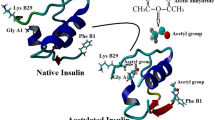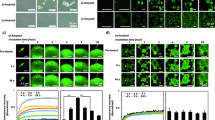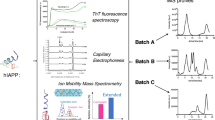Abstract
The milieu within pancreatic β cells represents a favorable environment for glycation of insulin. Therefore, in this study, insulin samples were individually subjected to glycation under reducing and nonreducing conditions. As monitored by ortho-phthalaldehyde and fluorescamine assays, the reduced glycated insulin adduct demonstrates extensively higher level of glycation than the nonreduced glycated counterpart. Also, gel electrophoresis experiments suggest a significant impact of glycation under a reducing system on the level of insulin oligomerization. Furthermore, reduced and nonreduced glycated insulin adducts respectively exhibit full and partial resistance against dithiothreitol-induced aggregation. The results of thioflavin T and Congo red assays suggest the existence of a significant quantity of amyloid-like entities in the sample of reduced glycated insulin adduct. Both fluorescence and far-ultraviolet circular dichroism studies respectively suggest that the extents of unfolding and secondary structural alteration were closely correlated to the level of insulin glycation. Moreover, the surface tension of two glycated insulin adducts was inversely correlated to their glycation extents and to the quantity of exposed hydrophobic patches. Overall, the glucose-modified insulin molecules under reducing and nonreducing systems display different structural features having significant consequences on aggregation behaviors and surface tension properties. The particular structural constraints of glycated insulin may reduce the binding interaction of this hormone to its receptor which is important for both insulin function and clearance.








Similar content being viewed by others
References
Nielsen, L., Frokjaer, S., Brange, J., Uversky, V. N., & Fink, A. L. (2001). Probing the mechanism of insulin fibril formation with insulin mutants. Biochemistry, 40, 8397–8409.
Nystrom, F. H., & Quon, M. J. (1999). Insulin signalling: Metabolic pathways and mechanisms for specificity. Cellular Signalling, 11, 563–574.
Ottensmeyer, F., Beniac, D. R., Luo, R. Z. T., & Yip, C. C. (2000). Mechanism of transmembrane signaling: Insulin binding and the insulin receptor. Biochemistry, 39, 12103–12112.
Oliveira, L., Lages, A., Gomes, R., Neves, H., Familia, C., Coelho, A., et al. (2011). Insulin glycation by methylglyoxal results in native-like aggregation and inhibition of fibril formation. BMC Biochemistry, 12, 41.
Abdel-Wahab, Y., O'Harte, F., Barnett, C., & Flatt, P. (1997). Characterization of insulin glycation in insulin-secreting cells maintained in tissue culture. The Journal of Endocrinology, 152, 59–67.
Abdel-Wahab, Y. H. A., O'Harte, F. P., Ratcliff, H., McClenaghan, N. H., Barnett, C. R., & Flatt, P. R. (1996). Glycation of insulin in the islets of langerhans of normal and diabetic animals. Diabetes, 45, 1489–1496.
Abdel-Wahab, Y., O'Harte, F., Boyd, A., Barnett, C., & Flatt, P. (1997). Glycation of insulin results in reduced biological activity in mice. Acta Diabetologica, 34, 265–270.
Mendez, D. L., Jensen, R. A., McElroy, L. A., Pena, J. M., & Esquerra, R. M. (2005). The effect of non-enzymatic glycation on the unfolding of human serum albumin. Archives of Biochemistry and Biophysics, 444, 92–99.
Solá, R. J., & Griebenow, K. (2008). Effects of glycosylation on the stability of protein pharmaceuticals. Journal of Pharmaceutical Sciences, 98, 1223–1245.
Westermark, P., Benson, M. D., Buxbaum, J. N., Cohen, A. S., Frangione, B., Ikeda, S. I., et al. (2005). Amyloid: Toward terminology clarification report from the nomenclature committee of the international society of amyloidosis. Amyloid, 12, 1–4.
Ledesma, M. D., Bonay, P., Colaco, C., & Avila, J. (1994). Analysis of microtubule-associated protein tau glycation in paired helical filaments. The Journal of Biological Chemistry, 269, 21614–21619.
Loske, C., Gerdemann, A., Schepl, W., Wycislo, M., Schinzel, R., Palm, D., et al. (2001). Transition metal-mediated glycoxidation accelerates cross-linking of β-amyloid peptide. European Journal of Biochemistry, 267, 4171–4178.
Hashimoto, N., Naiki, H., & Gejyo, F. (1999). Modification of beta 2-microglobulin with d-glucose or 3-deoxyglucosone inhibits A beta 2M amyloid fibril extension in vitro. Amyloid, 6, 256–264.
Lee, D., Park, C. W., Paik, S. R., & Choi, K. Y. (2009). The modification of α-synuclein by dicarbonyl compounds inhibits its fibril-forming process. Biochimica et Biophysica Acta, 1794, 421–430.
Lo, T., Westwood, M. E., McLellan, A. C., Selwood, T., & Thornalley, P. J. (1994). Binding and modification of proteins by methylglyoxal under physiological conditions. A kinetic and mechanistic study with N alpha-acetylarginine, N alpha-acetylcysteine, and N alpha-acetyllysine and bovine serum albumin. The Journal of Biological Chemistry, 269, 32299–32305.
Jia, X., Olson, D. J. H., Ross, A. R. S., & Wu, L. (2006). Structural and functional changes in human insulin induced by methylglyoxal. The FASEB Journal, 20, 1555–1557.
O'Harte, F. P. M., Højrup, P., Barnett, C. R., & Flatt, P. R. (1996). Identification of the site of glycation of human insulin. Peptides, 17, 1323–1330.
Guedes, S., Vitorino, R., Domingues, M. R. M., Amado, F., & Domingues, P. (2009). Mass spectrometry characterization of the glycation sites of bovine insulin by tandem mass spectrometry. Journal of the American Society for Mass Spectrometry, 20, 1319–1326.
Brange, J., & Langkjcer, L. (1993). Insulin strueture and stability. Pharmaceutical Biotechnology, 5, 315.
Watkins, N., Thorpe, S., & Baynes, J. (1985). Glycation of amino groups in protein. Studies on the specificity of modification of RNase by glucose. The Journal of Biological Chemistry, 260, 10629–10636.
Boyd, A. C., Abdel-Wahab, Y. H. A., McKillop, A. M., McNulty, H., Barnett, C. R., O’Harte, F. P. M., et al. (2000). Impaired ability of glycated insulin to regulate plasma glucose and stimulate glucose transport and metabolism in mouse abdominal muscle. Biochimica et Biophysica Acta, 1523, 128–134.
Fayle, S. E., Healy, J. P., Brown, P. A., Reid, E. A., Gerrard, J. A., & Ames, J. M. (2001). Novel approaches to the analysis of the Maillard reaction of proteins. Electrophoresis, 22, 1518–1525.
Schmitt, A., Schmitt, J., Münch, G., & Gasic-Milencovic, J. (2005). Characterization of advanced glycation end products for biochemical studies: Side chain modifications and fluorescence characteristics. Analytical Biochemistry, 338, 201–215.
Sattarahmady, N., Moosavi-Movahedi, A. A., Ahmad, F., Hakimelahi, G. H., Habibi-Rezaei, M., Saboury, A. A., et al. (2007). Formation of the molten globule-like state during prolonged glycation of human serum albumin. Biochimica et Biophysica Acta, 1770, 933–942.
Laemmli, U. (1970). Most commonly used discontinuous buffer system for SDS electrophoresis. Nature, 227, 680–685.
Schägger, H., & Von Jagow, G. (1987). Tricine–sodium dodecyl sulfate–polyacrylamide gel electrophoresis for the separation of proteins in the range from 1 to 100 kDa. Analytical Biochemistry, 166, 368–379.
Yousefi, R., Jalili, S., Alavi, P., & Moosavi-Movahedi, A. A. (2012). The enhancing effect of homocysteine thiolactone on insulin fibrillation and cytotoxicity of insulin fibril. International Journal of Biological Macromolecules, 51, 291–298.
Woods, L., Radford, S., & Ashcroft, A. (2012). Advances in ion mobility spectrometry-mass spectrometry reveal key insights into amyloid assembly. Biochimica et Biophysica Acta. doi:10.1016/j.bbapap.2012.10.002.
LeVine, H. (1999). Quantification of β-sheet amyloid fibril structures with thioflavin T. Methods in Enzymology, 309, 274–284.
Jalili, S., Yousefi, R., Papari, M. M., & Moosavi-Movahedi, A. A. (2011). Effect of homocysteine thiolactone on structure and aggregation propensity of bovine pancreatic insulin. The Protein Journal, 30, 299–307.
Matulis, D., & Lovrien, R. (1998). 1-Anilino-8-naphthalene sulfonate anion-protein binding depends primarily on ion pair formation. Biophysical Journal, 74, 422–429.
Hawe, A., Sutter, M., & Jiskoot, W. (2008). Extrinsic fluorescent dyes as tools for protein characterization. Pharmaceutical Research, 25, 1487–1499.
Divsalar, A., Saboury, A., & Moosavi-Movahedi, A. A. (2006). Conformational and structural analysis of bovine β lactoglobulin-A upon interaction with Cr+3. The Protein Journal, 25, 157–165.
Atri, M. S., Saboury, A. A., Yousefi, R., Dalgalarrondo, M., Chobert, J. M., Haertle, T., et al. (2010). Comparative study on heat stability of camel and bovine apo and holo alpha-lactalbumin. The Journal of Dairy Research, 77, 43–49.
Böhm, G., Muhr, R., & Jaenicke, R. (1992). Quantitative analysis of protein far UV circular dichroism spectra by neural networks. Protein Pngineering, 5, 191–195.
Kachooei, E., Moosavi-Movahedi, A. A., Khodagholi, F., Ramshini, H., Shaerzadeh, F., & Sheibani, N. (2012). Oligomeric forms of insulin amyloid aggregation disrupt outgrowth and complexity of neuron-like PC12 cells. PloS One, 7, e41344.
Brownlee, M. (1992). Glycation products and the pathogenesis of diabetics complications. Diabetes Care, 15, 1835–1843.
Takata, K., Horiuchi, S., Araki, N., Shiga, M., Saitoh, M., & Morino, Y. (1988). Endocytic uptake of nonenzymatically glycosylated proteins is mediated by scavenger receptor for aldehyde-modified proteins. The Journal of Biological Chemistry, 263, 14819–14825.
De Meyts, P., & Whittaker, J. (2002). Structural biology of insulin and IGF1 receptors: Implications for drug design. Nature Reviews. Drug Discovery, 1, 769–783.
Brange, J. (1992). Chemical stability of insulin: Mechanisms and kinetics of chemical transformations in pharmaceutical formulation. Acta Pharmaceutica Nordica, 4, 209–222.
Brownlee, M. (2000). Negative consequences of glycation. Metabolism, 49, 9–13.
Vitek, M. P., Bhattacharya, K., Glendening, J. M., Stopa, E., Vlassara, H., Bucala, R., et al. (1994). Advanced glycation end products contribute to amyloidosis in Alzheimer disease. Proceedings of the National Academy of Sciences, 91, 4766–4770.
Castellani, R., Smith, M., Richey, G., & Perry, G. (1996). Glycoxidation and oxidative stress in Parkinson disease and diffuse Lewy body disease. Brain Research, 737, 195–200.
Lyons, T. J., Silvestri, G., Dunn, J. A., Dyer, D. G., & Baynes, J. W. (1991). Role of glycation in modification of lens crystallins in diabetic and nondiabetic senile cataracts. Diabetes, 40, 1010–1015.
Dolhofer, R., & Wieland, O. (1979). Preparation and biological properties of glycosylated insulin. FEBS Letters, 100, 133–136.
Morgan, F., Léonil, J., Mollé, D., & Bouhallab, S. (1999). Modification of bovine β-lactoglobulin by glycation in a powdered state or in an aqueous solution: effect on association behavior and protein conformation. Journal of Agricultural and Food Chemistry, 47, 83–91.
Swamy, M., & Abraham, E. (1989). Inhibition of lens crystallin glycation and high molecular weight aggregate formation by aspirin in vitro and in vivo. Investigative Ophthalmology and Visual Science, 30, 1120–1126.
Ivanova, M. I., Sievers, S. A., Sawaya, M. R., Wall, J. S., & Eisenberg, D. (2009). Molecular basis for insulin fibril assembly. Proceedings of the National Academy of Sciences, 106, 18990–18995.
Ali Khan, M. W., Rasheed, Z., Ali Khan, W., & Ali, R. (2007). Biochemical, biophysical, and thermodynamic analysis of in vitro glycated human serum albumin. Biochemistry (Moscow), 72, 146–152.
Sattarahmady, N., Moosavi-Movahedi, A. A., & Habibi-Rezaei, M. (2011). A biophysical comparison of human serum albumin to be glycated in vivo and in vitro. Journal of Medical Biochemistry, 30, 5–10.
Messina, P., Prieto, G., Dodero, V., Cabrerizo-Vílchez, M., Maldonado-Valderrama, J., Ruso, J. M., et al. (2006). Surface characterization of human serum albumin and sodium perfluorooctanoate mixed solutions by pendant drop tensiometry and circular dichroism. Biopolymers, 82, 261–271.
Lin, F., Kwok, D., Policova, Z., Zingg, W., & Neumann, A. (1995). The effect of ph and concentration on the surface tension of adsorbed layers of various insulin preparations. Colloids and Surfaces. B, Biointerfaces, 3, 281–286.
Acknowledgments
We would like to acknowledge the financial support of Iran National Science Foundation (INSF)/grant number 88001578. The financial support of the research council of Shiraz University is also gratefully acknowledged.
Author information
Authors and Affiliations
Corresponding author
Rights and permissions
About this article
Cite this article
Alavi, P., Yousefi, R., Amirghofran, S. et al. Structural Analysis and Aggregation Propensity of Reduced and Nonreduced Glycated Insulin Adducts. Appl Biochem Biotechnol 170, 623–638 (2013). https://doi.org/10.1007/s12010-013-0207-1
Received:
Accepted:
Published:
Issue Date:
DOI: https://doi.org/10.1007/s12010-013-0207-1




